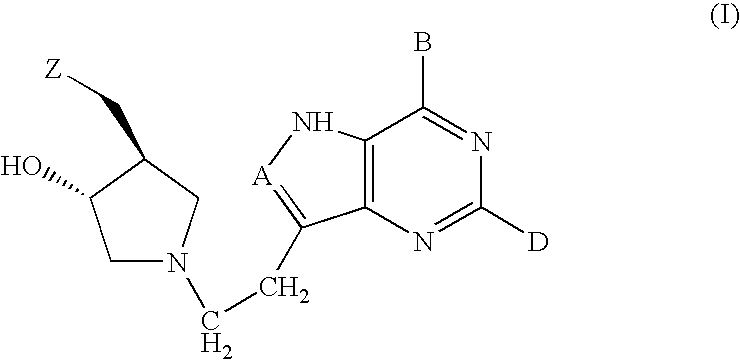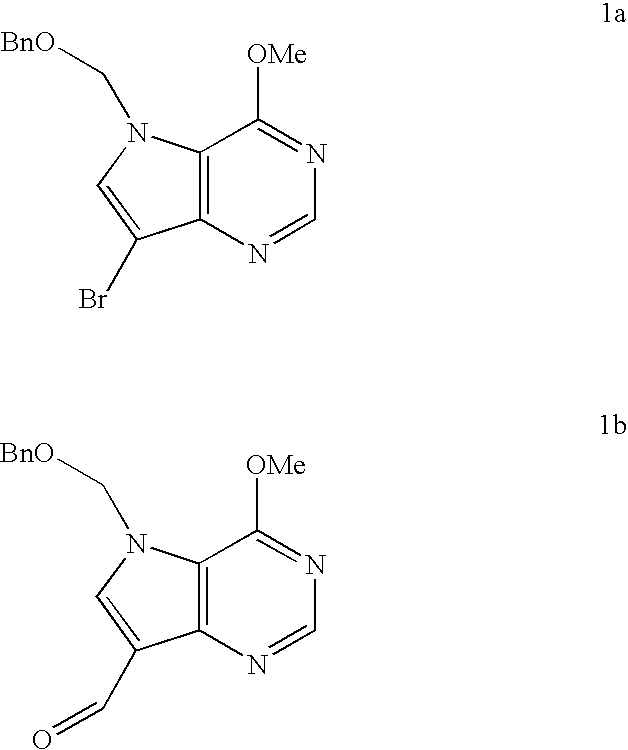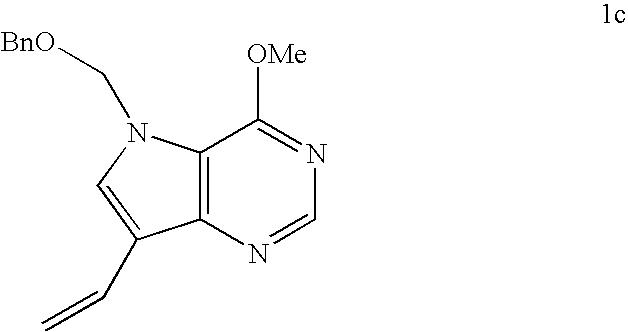Inhibitors of nucleoside phosphorylases and nucleosidases
a nucleosidases and nucleoside phosphorylase technology, applied in the field of nucleoside analogues, can solve the problems of limiting the polyamine biosynthesis and the salvage pathway of adenine in the cell, and achieve the effect of reducing the number of nucleoside analogues
- Summary
- Abstract
- Description
- Claims
- Application Information
AI Technical Summary
Benefits of technology
Problems solved by technology
Method used
Image
Examples
example 1
Synthesis of (3S,4S)-1-[2-(9-Deaza-hypoxanthin-9-yl)ethyl]-3-hydroxy-4-hydroxymethylpyrrolidine (1) [DAD-Et-Immucillin-H]
[0101]
[0102]n-Butyllithium (5.30 mL of a 1.3 M solution in hexanes, 6.90 mmol) was added to a solution of bromide 1a (2.00 g, 5.75 mmol) in diethyl ether (40 mL) and anisole (16 mL) under argon at −78° C. Thin-layer chromatography confirmed that no starting material remained. Dimethylformamide (4.4 mL, 57.5 mmol) was added and the mixture stirred at −78° C. for 30 minutes then the mixture was allowed to warm to room temperature. Dichloromethane (200 mL) was added and the solution was washed with water (100 mL), dried and the solvent was removed. The residue was chromatographed on silica gel to give compound 1b (1.20 g, 70%) as a white solid.
[0103]Methyltriphenylphosphonium bromide (1.20 g, 3.37 mmol) was suspended in tetrahydrofuran (25 mL) and cooled to −78° C. under an atmosphere of argon. n-Butyllithium (1.94 mL of a 1.3 M solution in hexanes, 2.52 mmol) was ad...
example 2
Synthesis of (3S,4R)-1-[2-(9-Deaza-adenin-9-yl)ethyl]-3-hydroxy-4-methylthiomethylpyrrolidine (2) [Methylthio-DAD-Et-Immucillin-A]
[0109]
3-Cyanopropyl benzoate (2b)
[0110]A mixture of bromobutyronitrile (2a) (7.45 g, 50.3 mmol), sodium benzoate (14.5 g, 101 mmol), tetrabutylammonium hydrogen sulfate (34.2 g, 101 mmol) and molecular sieves (1 g) in dry acetone (100 ml) was heated under reflux for 4 hrs. The reaction mixture was cooled to RT and filtered through the celite pad and concentrated to dryness. Dichloromethane was added and the mixture was washed with sat. NaHCO3 followed by water, dried and concentrated. Chromatography (EtOAc:petroleum ether, 1:4) afforded 9.5 g (100%) of (2a) as clear syrup. 1H NMR (CDCl3) δ 8.02-8.12 (m, 2H), 7.41-7.59 (m, 3H), 4.42 (t, 2H), 2.52 (t, 2H), 2.13 (m, 2H); 13C NMR δ 171.5 (C), 166.7 (C), 134.0 (CH), 133.6 (CH), 130.5 (CH), 130.1 (CH), 130.0 (CH), 128.9 (CH), 119.3 (C), 63.1 (CH2), 25.4 (CH2), 14.8 (CH2).
4-(Trityloxy)butanenitrile (2c)
[0111]To ...
example 3
Inhibition Studies
[0120]Initial (Ki) and equilibrium (Ki*) dissociation constants of DAD-Et-Immucillin-H were determined for human PNP.
[0121]Inhibitor dissociation constants for the phosphorolysis of inosine were based on initial and equilibrium reaction rate measurements with varied inhibitor concentrations (Miles, R. W., Tyler, P. C., Furneaux, R. H., Bagdassarian, C. K. and Schramm, V. L. (1998) One-third-the-sites transition state inhibitors for purine nucleoside phosphorylase, Biochemistry 37, 8615-8621; Morrison, J. F. and Walsh, C. T. (1988) The behaviour and significance of slow-binding enzyme inhibitors, Adv. Enzymol. Relat. Areas Mol. Biol. 61, 201-301). Reactions were started by adding huPNP (1.4 nM) to reaction mixtures (25° C.) containing 1 mM inosine in 50 mM KHPO4 pH 7.4 with xanthine oxidase at 60 mU / ml. Hypoxanthine formed by phosphorolysis of inosine was oxidized to uric acid and monitored spectrophotometrically at 293 nm (extinction coefficient for uric acid ε293=...
PUM
| Property | Measurement | Unit |
|---|---|---|
| temperature | aaaaa | aaaaa |
| pH | aaaaa | aaaaa |
| length | aaaaa | aaaaa |
Abstract
Description
Claims
Application Information
 Login to View More
Login to View More - R&D
- Intellectual Property
- Life Sciences
- Materials
- Tech Scout
- Unparalleled Data Quality
- Higher Quality Content
- 60% Fewer Hallucinations
Browse by: Latest US Patents, China's latest patents, Technical Efficacy Thesaurus, Application Domain, Technology Topic, Popular Technical Reports.
© 2025 PatSnap. All rights reserved.Legal|Privacy policy|Modern Slavery Act Transparency Statement|Sitemap|About US| Contact US: help@patsnap.com



